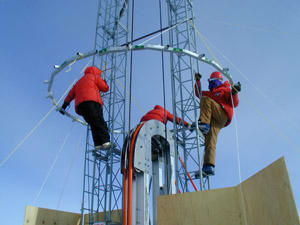The Antarctic Muon and Neutrino Detector Array (AMANDA) was a neutrino telescope located beneath the Amundsen-Scott South Pole Station. It consists of optical modules, each containing one photomultipler tube, sunk in Antarctic ice cap at a depth of about 1500 to 1900 meters. In its latest development stage, known as AMANDA-II, AMANDA is made up of an array of 677 optical modules mounted on 19 separate strings that are spread out in a rough circle with a diameter of 200 meters. Each string has several dozen modules, and was put in place by “drilling” a hole in the ice using a hot water hose, sinking the cable with attached optical modules in, and then letting the ice freeze around it.

AMANDA detects very high energy neutrinos (50+ GeV) which pass through the Earth from the northern hemisphere and then react just as they are leaving upwards through the Antarctic ice. The neutrino collides with nuclei of oxygen or hydrogen atoms contained in the surrounding water ice, producing a muon and a hadronic shower. The optical modules detect the Cherenkov radiation from these particles, and by analysis of the timing of photon hits can approximately determine the direction of the original neutrino with a spatial resolution of approximately 2 degrees.
AMANDA’s goal was identifying and characterizing extra-solar sources of neutrinos. Compared to underground detectors like Super-Kamiokande in Japan, AMANDA is capable of looking at higher energy neutrinos because it is not limited in volume to a man-made tank. However, it has much less accuracy due to the less controlled conditions and wider spacing of photomultiplers. Super-Kamiokande can look at much greater detail at neutrinos from the Sun and those generated in the Earth’s atmosphere. However, at higher energies the spectrum should include neutrinos dominated by those from sources outside the solar system. Such a new view into the cosmos could give important clues in the search for Dark Matter and other astrophysical phenomena.
In 2005, after nine years of operation, AMANDA officially became part of its successor project, IceCube.